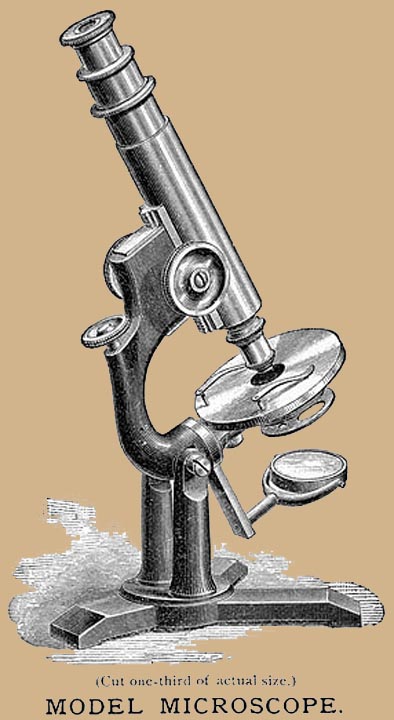| DESCRIPTION | HISTORY |
 American and from 1887, signed 'Bausch & Lomb Optical Co' and 'Pat Oct 3, 1876' and 'Pat Oct 13 1885' and serial numbered 5142 in the case. Although the original specification card was present originally, dating the microscope to 1887, this card is now missing. It is constructed of painted cast iron, lacquered brass, and nickel plated finishes. It features rack and pinion coarse focus and Gundlach screw fine focus, a substage wheel or apertures, and a swinging tailpiece with plano-concave mirror which is gimballed and can also slide up and down the tailpiece. A very solid stand, for a
reasonable price, it was very popular, as evidenced by the fair number of examples still extant.
The outfit includes:
American and from 1887, signed 'Bausch & Lomb Optical Co' and 'Pat Oct 3, 1876' and 'Pat Oct 13 1885' and serial numbered 5142 in the case. Although the original specification card was present originally, dating the microscope to 1887, this card is now missing. It is constructed of painted cast iron, lacquered brass, and nickel plated finishes. It features rack and pinion coarse focus and Gundlach screw fine focus, a substage wheel or apertures, and a swinging tailpiece with plano-concave mirror which is gimballed and can also slide up and down the tailpiece. A very solid stand, for a
reasonable price, it was very popular, as evidenced by the fair number of examples still extant.
The outfit includes: This is the B & L 'Model' microscope, a microscope of solid and basic construction. This microscope was designed to be of modest cost, yet able to be used for more sophisticated
work with additional accessories added by the purchaser.
By saving the large initial expense of more sophisticated models, the buyer could fit it as required. As follows in the company description:
This is the B & L 'Model' microscope, a microscope of solid and basic construction. This microscope was designed to be of modest cost, yet able to be used for more sophisticated
work with additional accessories added by the purchaser.
By saving the large initial expense of more sophisticated models, the buyer could fit it as required. As follows in the company description:'MODEL MICROSCOPE. This microscope was originally constructed in compliance with a generally expressed demand for a simple, relatively low-price and well-made instrument, which is adapted to every grade of work, and claim that in it we have a model which possesses, in an eminent degree, these qualities. Probably no low-price instrument has ever been offered the public, which has been so favorably received and met with such ready sale as this. It is of chaste design, its parts are all calculated to bear the strain of every-day work, and on this account and because of its simplicity, it may be used by inexperienced hands, without detriment or injury to it. This microscope especially recommends itself by requiring a smaller pecuniary outlay than any of similar construction, and may be supplied with valuable additions, such as our revolving and glass stages, mirror-bar with adjustable mirror and sub-stage, all of which greatly increase the efficiency and add but little to the price of the instrument. The tripod base, pillars and arm, are neatly japanned; the axis is arranged with strong bearings to allow inclination of the body to any angle. Coarse adjustment is by perfect rack and pinion, provided with tightening screws; fine adjustment by a delicate micrometer screw, acting on our patent movement. As at present constructed, the arm is considerably lengthened to allow the more convenient use of low-power objectives, as well as the double, triple and quadruple nosepieces. The stage is of brass, circular in form, thin to allow great obliquity, but of sufficient strength to be firm under manipulation. Attached to its lower side is a sub-stage ring and revolving diaphragm, both of which maybe removed. The main tube is arranged with cloth lining, in which the draw-tube is fitted; it is provided with the society screw to receive low-power objectives, amplifier or analyzer of polariscope. Plane and concave mirrors are of large size, adjustable on the mirror-bar, which is a feature possessed by few low-price instruments, although it is of considerable importance, from the fact that a change in the distance of the light requires a corresponding adjustment of the mirrors; the mirror-bar swings on a large bearing (the axis of which lies in the plane of the stage) to any obliquity below and above the stage, the latter for the illumination of opaque objects.'